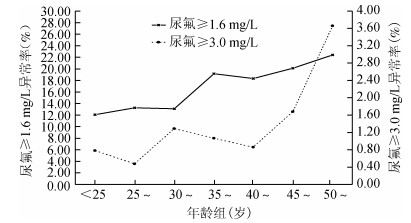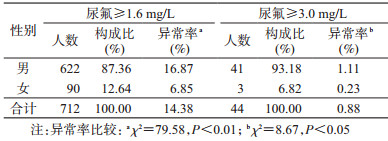文章信息
- 顾明华, 苏瑾, 刘长河, 朱银泉, 沈昊, 黄月华, 钟岚, 章敏华, 李延红 .
- Gu Minghua, Su Jin, Liu Changhe, Zhu Yinquan, Shen Hao, Huang Yuehua, Zhong Lan, Zhang Minhua, Li Yanhong .
- 上海市2012-2015年无机氟作业人群尿氟异常率流行特征研究
- Epidemiological pattern of abnormal urinary fluoride rates in population with occupational fluoride exposure in Shanghai
- 中华流行病学杂志, 2017, 38(1): 77-80
- Chinese journal of Epidemiology, 2017, 38(1): 77-80
- http://dx.doi.org/10.3760/cma.j.issn.0254-6450.2017.01.015
-
文章历史
收稿日期: 2016-08-23
2. 200336 上海市疾病预防控制中心健康安全评价所
2. Department of Social Services and Public Health Assessment, Shanghai Municipal Center for Disease Control and Prevention, Shanghai 200336, China
目前我国现行的职业尿氟的生物接触限值为班前4 mg/g肌酐和班末7 mg/g肌酐[1],相当于班前尿氟6.8 mg/L和班末11.9 mg/L[2];而WHO认为班前尿氟浓度如果一直控制在4 mg/L以下,发生氟中毒的可能性很小;美国政府工业卫生师协会(American Conference of Government Industrial Hygienists,ACGIH)2012年规定尿氟职业接触生物接触限值修订为班前2 mg/L和班末3 mg/L[3]。国内对职业性氟接触人群的氟负荷研究局限在小样本用算术平均数表示平均浓度的单因素分析[4-10],而针对尿氟异常率且采用几何均数表示平均浓度的大样本多因素的研究不多。本研究对上海市无机氟作业人群的尿氟蓄积水平特征进行分析,重点探讨从业年限、年龄、性别对尿氟异常率的影响,评估相关的高风险脆弱人群。
对象与方法1.研究对象:职业暴露人群:2012-2015年上海市职业健康监护临床检验系统中接触氟从业人员共计4 999例。非暴露人群:选自上海市2012-2015年职业健康监护临床检验系统中非接触氟从业人员共计283例。
2.研究方法:
(1)健康检查:参考GBZ 188-2014 《职业健康监护技术规范》,检查项目:职业接触史和症状病史询问、内科、口腔科、骨关节检查、尿氟、血常规、尿常规、ALT、心电图、胸片等。
(2)尿样采集、运输和保存:尿氟测定采集班前清晨尿样100 ml于清洁聚乙烯瓶中,尽快测定比重,4 ℃下保存2周。
(3)尿氟测定:根据中华人民共和国卫生行业标准《尿中氟的离子选择电极测定方法》(WS/T 30-1996)进行测定。
(4)尿氟评价标准:根据中华人民共和国卫生行业标准WS/T 256-2005 《人群尿氟正常值》中成年人群体尿氟标准,以几何均值作为评价人群尿氟水平的指标,尿氟<1.6 mg/L为正常。
3.统计学分析:用Excel 2010软件建立数据库及SPSS 21.0软件进行数据分析,应用偏态分布的相应公式计算统计量,对不同分组人群的尿氟浓度等进行统计学差异检验比较,以P<0.05为差异有统计学意义。采用logistic回归进行多因素分析,控制年龄、性别、工龄及其他变量间的混杂效应。多因素分析时变量的赋值:性别:0=女性,1=男性;年龄:0=<25岁,1=25~岁,2=30~岁,3=35~岁,4=40~岁,5=45~岁,6=≥50岁;接毒工龄:0=<4年,1=4~年,2=8~年,3=12~年,4=16~年,5=20~年,6=≥24年;尿氟:1=≥1.6 mg/L,0=<1.6 mg/L。
结果1.基本特征:在4 999例氟暴露人群中,男性3 686例,女性1 313例,男女性别比为2.81:1;年龄17~62(29.63±8.15)岁;其接毒时间为0.5~40年,其中<4年3 221例,占66.37%;4~7.99年831例,占17.12%;8~11.99年432例,占8.90%;12~15.99年123例,占2.53%;16~19.99年130例,占2.68%;≥20年116例,占2.39%。平均接毒时间为(3.80±5.39)年。283例非暴露人群中,男性217例,女性66例,男女性别比为3.28:1;年龄17~59(29.16±6.76)岁。暴露组与非暴露组的内部构成比较显示,性别(χ2=1.03,P=0.30)及年龄(t=0.95,P=0.34)差异无统计学意义。
2.无机氟职业暴露与非暴露人群尿氟蓄积水平:2012-2015年上海市无机氟职业暴露与非暴露人群尿氟几何均数分别为0.95 mg/L和0.46 mg/L,暴露组尿氟异常率(14.38%)高于非暴露组(1.43%);经非参数统计检验对比组之间的差异,结果显示,差异有统计学意义(Z=-17.99,P<0.01)。见表 1。
3.职业暴露人群尿氟异常率的年龄分布:2012-2015年尿氟异常率的年龄差异分布:在超过人群尿氟正常值(≥1.6 mg/L)的从业人员中,34~39岁的青年组与50~岁的中年组超标率最高,分别为19.15%和22.39%(χ2=29.47,趋势检验P<0.01)。在尿氟超过≥3.0 mg/L的从业人员中,30~34岁的青年组与50~岁的中年组异常率最高,分别为1.29%和3.66%,差异均无统计学意义(χ2=7.63,趋势检验P>0.05)。见图 1。

|
| 图 1 2012-2015年上海市职业暴露人群尿氟异常率的年龄差异 |
4.不同性别职业暴露人群尿氟异常率的分布:2012-2015年上海市男性暴露人群尿氟异常率均明显高于女性,其中尿氟≥1.6 mg/L的异常人群中男性比例为87.36%,其对应的异常率为16.87%,尿氟≥3.0 mg/L的异常人群中男性比例为93.18%,其对应的异常率为1.11 %。见表 2。
5.职业暴露人群不同接毒工龄尿氟异常率:人群尿氟蓄积水平随着接毒工龄的增加逐渐升高。接毒工龄≥20年尿氟几何均数为1.09 mg/L,而工龄<4年者为0.92 mg/L,增加了18.48%(χ2=47.98,P<0.01);特别值得一提的是在尿氟≥1.6 mg/L人群中,接毒工龄>20年者的异常率为23.28%,而<4年者的异常率为13.29%,增加了75.17%(χ2=34.68,P<0.01)。见图 2。

|
| 图 2 2012-2015年上海市职业暴露人群不同接毒工龄尿氟异常率 |
6.尿氟异常值的logistic回归多因素分析:控制年龄、性别、接毒工龄变量间的混杂效应,结果显示,男性、年龄越大和接毒工龄越长发生尿氟异常值的风险越大;其OR值分别为2.28、1.10和1.13。见表 3。
与美国等发达国家的生物接触值采用尿比重浓度值(mg/L)表达不同[3, 11-12],我国目前现行的职业接触氟及其无机化合物的生物限值WS/T 240-2004仍然使用尿肌酐(mg/g肌酐)的表示方法。由于尿肌酐易受到饮食等因素的影响,尤其是在人群调查时难以消除这些因素的干扰,有研究建议在人群调查时采用尿比重浓度(mg/L)表示氟含量[13]。本研究采用国际通用的mg/L表示人群氟负荷的情况,直观简单、方便比较;同时列举了群体尿氟算术平均数、中位数、几何均数三项集中趋势指标的差异对比,由于群体尿氟含量是偏态分布,故建议采用几何均数表示氟暴露的负荷平均水平。
近几年,随着安监部门对企业监管的不断加强,企业对生产工艺的改进和工程防护的重视,作业环境中无机氟浓度超过国家标准的很少,除了泄露事故外,劳动者更多的是接触低浓度无机氟。2004年我国颁布的职业接触氟及其无机化合物的生物限值为班前4 mg/g肌酐,班后7 mg/g肌酐,换算为班前6.8 mg/L,班后11.9 mg/L,超越了WHO安全建议值4 mg/L,同时班前、班后浓度分别高于美国标准的3.40倍和3.97倍[1, 3]。而国内的一些相关研究结果差异较大[14-15],样本量较小且多用算术平均数表示平均浓度的单因素分析[16];本研究使用大样本几何均数表示平均蓄积水平,结果显示,超过我国职业接触生物限值(≥6.8 mg/L)的比例为0,提示对于低浓度接触的劳动者来说,我国的生物限值过高,不能有效起到监测低浓度接触人群尿氟水平、异常值预警的作用。结果同时显示,如果将尿氟正常限值定为3 mg/L和2 mg/L,将分别有99%和93%的人群数据属于正常范围,故建议尿氟职业接触限值班前尿氟修改为3 mg/L或2.5 mg/L。
国内大样本多因素分析尿氟异常率危险因素的文献报道较为罕见。本研究发现,尿氟异常率高低与年龄和接毒工龄的关系呈正相关,即年龄和接毒工龄越长,尿氟越容易发生异常且危害程度越大,特别是男性暴露人群。其原因可能是年龄越大、接毒工龄越长的男性作业者,其暴露的风险机会越大;同时可能这部分人群的经济状况较差,文化程度较低,缺乏自我保护意识,获取职业危害防护知识的机会和途径较少,间接提高了从业暴露的风险,从而使得尿氟异常率发生明显增加。在目前新医改实施的基本公共卫生服务均等化体系中,增加面对高风险人群的健康监护策略,融入简单易学的预防职业防护服务产品,就能更好地提升公共卫生服务的质量和覆盖范围。
本研究结果还显示,34~39岁的青年组与>50岁的中年组的异常率风险和程度最高,因此下一步应该作为重点人群进行干预。
利益冲突: 无
| [1] |
中华人民共和国卫生部. WS/T 240-2004职业接触氟及其无机化合物的生物限值[S].北京:中国标准出版社, 2004.
The Ministry of Health of the People's Republic of China. WS/T 240-2004 Biological limit value for occupational exposure to fluorine and fluorides[S]. Beijing:China Standard Publishing House, 2004. |
| [2] |
张秀梅, 聂庆东, 赵静, 等.
72例健康人尿密度和尿肌酐相关性分析[J]. 中国职业医学 , 2012, 39(3) : 239–241.
Zhang XM, Nie QD, Zhao J, et al. Correlation analysis between urine specific gravity and urinary creatinine of 72 health persons[J]. Chin Occup Med , 2012, 39(3) : 239–241. |
| [3] | ACGIH. Threshold Limit Values for Chemical Substances and Physical Agents and Biological Exposure Indices, 2012[M]. |
| [4] | Li Y, Zhang H, Zhang Z, et al. Treatment and resource recovery from inorganic fluoride-containing waste produced by the pesticide industry[J]. J Environ Sci (China) , 2015, 31 : 21–29. DOI:10.1016/j.jes.2014.10.016 |
| [5] |
涂俊, 刘克俭, 李明峰, 等.
职业性氟接触人群血氟、尿氟水平及相关因素研究[J]. 中国工业医学杂志 , 2010, 23(3) : 163–165, 172.
Tu J, Liu KJ, Li MF, et al. Study on fluorine levels in blood and urine and their correlation factors in occupational population exposed to fluoride[J]. Chin J Ind Med , 2010, 23(3) : 163–165, 172. |
| [6] |
张琳, 李卫星, 李郑, 等.
长期低浓度接触氟工人尿氟含量调查[J]. 中国厂矿医学 , 2007, 20(6) : 701.
Zhang L, Li WX, Li Z, et al. Study on urine fluorine levels among workers on long-term exposure to low fluoride concentration[J]. Chin Med Fact Mine , 2007, 20(6) : 701. DOI:10.3969/j.issn.1674-8182.2007.06.105 |
| [7] |
王滨滨, 郑宝山, 翟城, 等.
我国部分城市和地区水氟与尿氟含量的相关性[J]. 中国公共卫生 , 2004, 20(10) : 1226–1227.
Wang BB, Zheng BS, Zhai C, et al. Relation of fluorine contents in uine of townsmen and drinking water[J]. Chin J Public Health , 2004, 20(10) : 1226–1227. DOI:10.3321/j.issn.1001-0580.2004.10.035 |
| [8] |
吕敏, 龚利强, 丁帮梅, 等.
常熟市接触氟化合物作业工人哨点监测结果分析[J]. 江苏预防医学 , 2014, 25(6) : 6–8.
Lyu M, Gong LQ, Ding BM, et al. Sentinel surveillance analysis on workers contact with fluorine compounds in Changshu city[J]. Jiangsu J Prey Med , 2014, 25(6) : 6–8. DOI:10.13668/j.issn.1006-9070.2014.06.003 |
| [9] |
杨得明, 蒲朝文, 李恒, 等.
电解铝作业场所空气氟污染与工人尿氟含量相关分析[J]. 职业卫生与病伤 , 2012, 27(2) : 67–68.
Yang DM, Pu CW, Li H, et al. Correlation of fluoride in workplace air and the urinary fluoride of workers exposed to aluminum potrooms[J]. J Occup Heal Dam , 2012, 27(2) : 67–68. DOI:10.3969/j.issn.1006-172X.2012.02.001 |
| [10] |
莫志亚, 杜波, 房连营, 等.
吉林省地方性氟中毒11年监测尿氟结果分析[J]. 中国地方病防治杂志 , 2007, 22(2) : 121–122.
Mo ZY, Du B, Fang LY, et al. Analysis on the surveillance results of endemic fluorosis in Jilin province in the past eleven years[J]. Chin J Ctrl Endem Dis , 2007, 22(2) : 121–122. DOI:10.3969/j.issn.1001-1889.2007.02.014 |
| [11] |
张志虎, 黄金祥.
职业接触生物限值研究现状[J]. 中华劳动卫生职业病杂志 , 2013, 31(12) : 955–960.
Zhang ZH, Huang JX. Studies on the biological limit value of occupatinal exposures[J]. Chin J Ind Hyg Occup Dis , 2013, 31(12) : 955–960. DOI:10.3760/cma.j.issn.1001-9391.2013.12.024 |
| [12] | World Health Organization. Biological monitoring of chemical exposure in the workplace[R]. Geneva:World Health Organization, 1996. |
| [13] |
吕严, 吴丽娜.
尿肌酐标化尿氟含量的探讨[J]. 中国地方病防治杂志 , 2003, 18(6) : 374–375.
Lyu Y, Wu LN. Discuss of fluoride content of urine was standardized with urine creatinine[J]. Chin J Ctrl Endem Dis , 2003, 18(6) : 374–375. DOI:10.3969/j.issn.1001-1889.2003.06.023 |
| [14] |
于光前, 孙殿军.
尿氟在地方性氟中毒防治中的意义[J]. 中国地方病防治杂志 , 2003, 22(1) : 78–80.
Yu GQ, Sun DJ. The significance of urinary fluoride content on the endemic fluorosis[J]. Chin J Ctrl Endem Dis , 2003, 22(1) : 78–80. DOI:10.3760/cma.j.issn.1000-4955.2003.01.029 |
| [15] |
孙殿军, 王丽华.
国际氟研究最新进展:第24届国际氟研究协会学术会议[J]. 中国地方病学杂志 , 2002, 21(5) : 410–412.
Shun DJ, Wang LH. The new progress of international fluoride research-The 24th world conference of the international society for fluoride research[J]. Chin J Ctrl Endem , 2002, 21(5) : 410–412. DOI:10.3760/cma.j.issn.1000-4955.2002.05.026 |
| [16] |
蔡健峰, 王志勇, 林文敏, 等.
磷肥厂接触氟化物工人尿氟与血氟测定结果研究[J]. 海峡预防医学杂志 , 2003, 9(3) : 37–38.
Cai JF, Wang ZY, Lin WM, et al. Study on fluorine in urine and blood of workers in phosphate fertilizer plants[J]. Strait J Prev Med , 2003, 9(3) : 37–38. DOI:10.3969/j.issn.1007-2705.2003.03.016 |
 2017, Vol. 38
2017, Vol. 38





